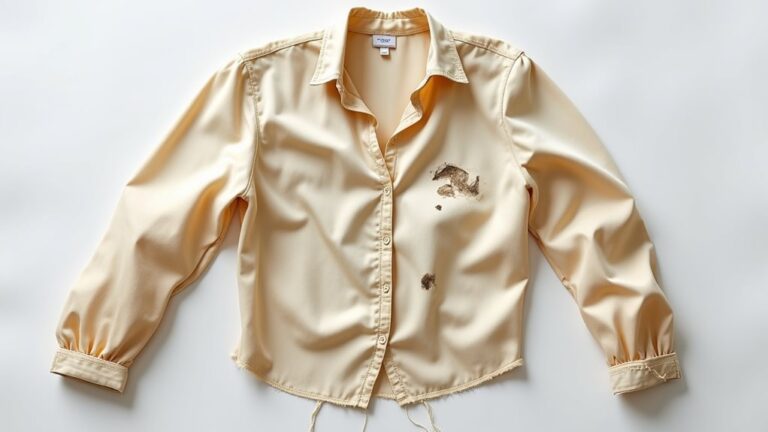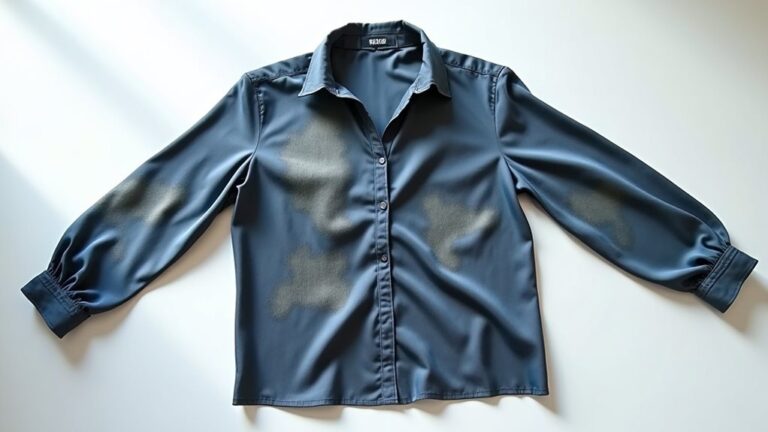If you wash a dry clean only garment, you’ll watch your investment transform into an expensive disaster—I learned this the hard way with a wool blazer that emerged fitting my toddler nephew! Water attacks the molecular structure while agitation stretches and twists delicate fibers, causing permanent shrinkage exceeding 10%, texture destruction, and color bleeding that creates unwanted tie-dye effects. Your silk blouse will lose its luxurious sheen, becoming dull and misshapen, while your wool sweater develops rough, felted patches that no amount of coaxing can restore. These changes happen immediately and irreversibly, leaving you with structurally damaged clothes that simply can’t return to their original form, and understanding exactly why this occurs can help you protect your wardrobe’s future.
Understanding What Dry Clean Only Labels Really Mean
When I first started doing my own laundry in college, I’ll admit I was that person who threw everything into the washing machine without reading a single care label – a mistake that cost me my favorite wool sweater and taught me a valuable lesson about respecting fabric requirements.
That tiny dry clean only tag isn’t just a suggestion from manufacturers trying to make your life difficult; it’s actually protecting your investment.
These labels appear on delicate fabrics like silk, wool, and structured garments that contain special finishes or embellishments that water and agitation can destroy.
Think of care labels as your clothing’s survival guide, designed to help you avoid the heartbreak of watching a beautiful garment transform into an unwearable disaster 😅.
Learning how to read care labels properly can save you from costly mistakes and help you determine which items truly need professional cleaning versus those that might be safely washed at home.
Immediate Physical Changes to Your Garment
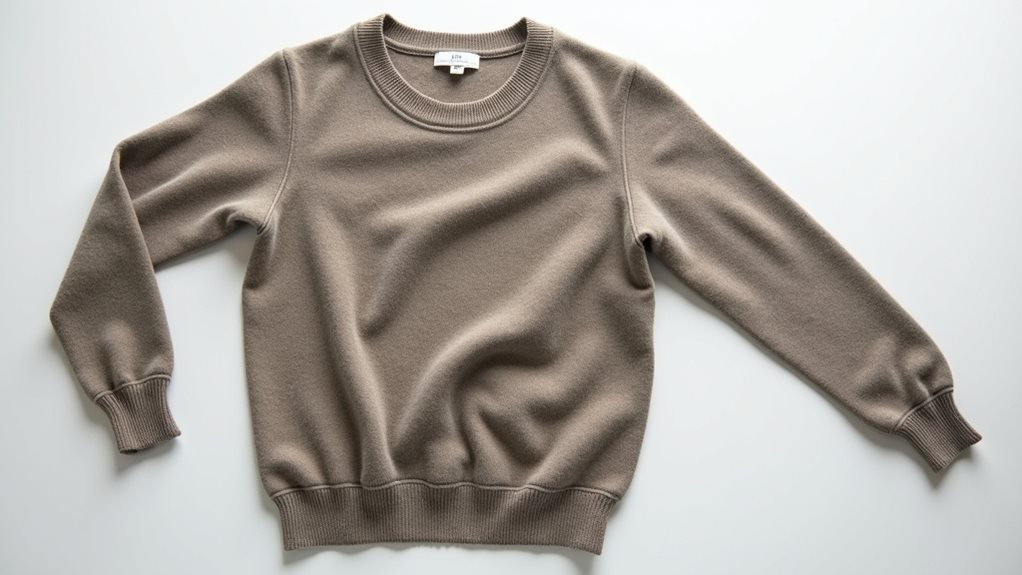
When you ignore that “dry clean only” label and toss your favorite garment into the washing machine, you’re fundamentally rolling the dice with its entire physical structure, and trust me, the house usually wins.
Your once-perfectly fitted wool sweater might emerge looking like it was designed for your little sister, while that luxurious silk blouse could transform from buttery sleek to feeling like you’re wearing sandpaper against your skin.
These immediate changes aren’t just cosmetic annoyances—they’re permanent alterations that can turn a cherished piece into an expensive reminder of why those care labels exist in the first place.
This happens because water and heat cause fabric fibers to contract in ways that chemical solvents used in proper dry cleaning would never trigger, fundamentally altering the garment’s original dimensions and texture.
Shrinkage and Size Loss
Although that luxurious cashmere sweater might seem like it could survive a gentle wash cycle, you’re fundamentally playing Russian roulette with your wardrobe, and trust me, the house always wins.
When you wash dry clean only garments, shrinkage becomes your worst nightmare, with wool and silk potentially losing 10% or more of their original size depending on water temperature and agitation levels.
Different fabric types within the same garment create additional chaos, as your wool blazer’s rayon lining might shrink faster than the outer shell, leaving you with a puckered, distorted mess that resembles something from a funhouse mirror.
Once that structural damage occurs, there’s no going back – your perfectly fitted jacket becomes an expensive lesson in following care labels.
Even chemical solvents used in professional dry cleaning can sometimes cause shrinkage if the cleaner uses excessive heat, making water-based washing an even riskier gamble for delicate fabrics.
Fabric Texture Alteration
Beyond the devastating size changes lurking in your washing machine, the actual feel and appearance of your beloved garments undergo an equally heartbreaking transformation that’ll make you question every life choice that led to this moment.
When fabric texture alteration strikes your dry clean only garment, you’re witnessing delicate fabrics losing their soul—literally changing their molecular structure under water’s relentless assault.
The texture changes you’ll experience include:
- Silk losing its lustrous sheen, transforming from elegant glamour into sad, dull fabric that looks like it’s given up on life 😢
- Wool developing rough, felted patches that feel like sandpaper against your skin.
- Embellished areas puckering unnaturally, creating bizarre waves where sleek sophistication once lived.
Your garment’s original character simply vanishes. Water exposure also compromises special finishes on your garment, permanently altering the carefully applied treatments that gave the fabric its unique properties and luxurious feel.
Fabric-Specific Damage You Can Expect
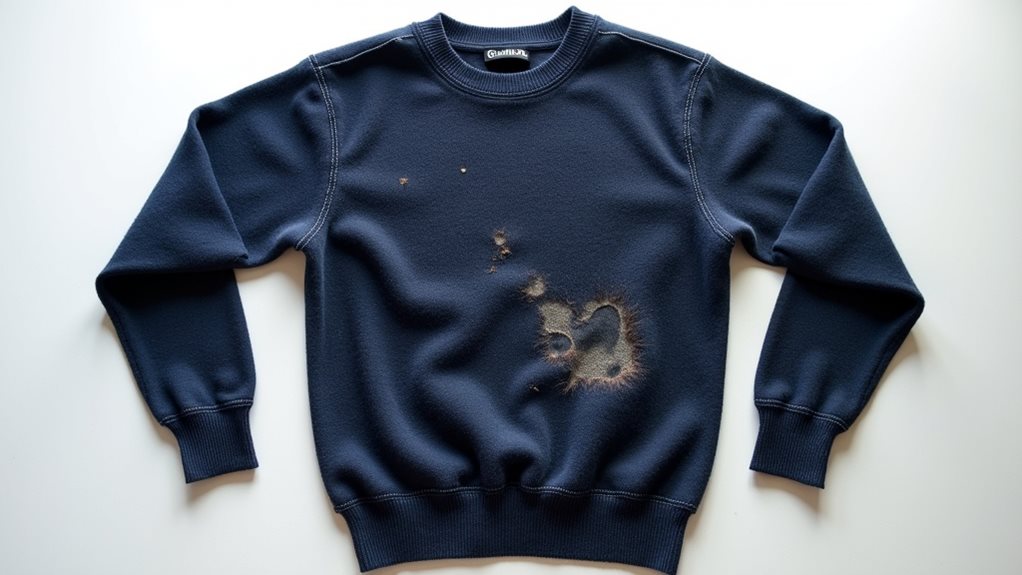
Since different fabrics react to water and agitation in dramatically different ways, understanding what you’re risking before you toss that “dry clean only” garment into your washing machine can save you from some pretty heartbreaking wardrobe casualties.
When you wash delicate fabrics like wool, you’re fundamentally watching expensive clothing transform into doll-sized disappointments through shrinking and felting. Silk becomes a weakened shadow of its former lustrous self, while rayon linings can distort beyond recognition.
I’ve learned this lesson the hard way with a beloved blazer that emerged looking like it belonged to my 12-year-old nephew! Structured garments lose their customized precision, and those gorgeous sequined details? They’ll scatter across your washing machine like expensive confetti, leaving your dry clean only clothes permanently altered.
The damage occurs because these delicate materials have sensitivity to water and mechanical agitation that causes the fibers to break down in ways that professional dry cleaning solvents avoid.
Why Water and Agitation Cause Irreversible Harm
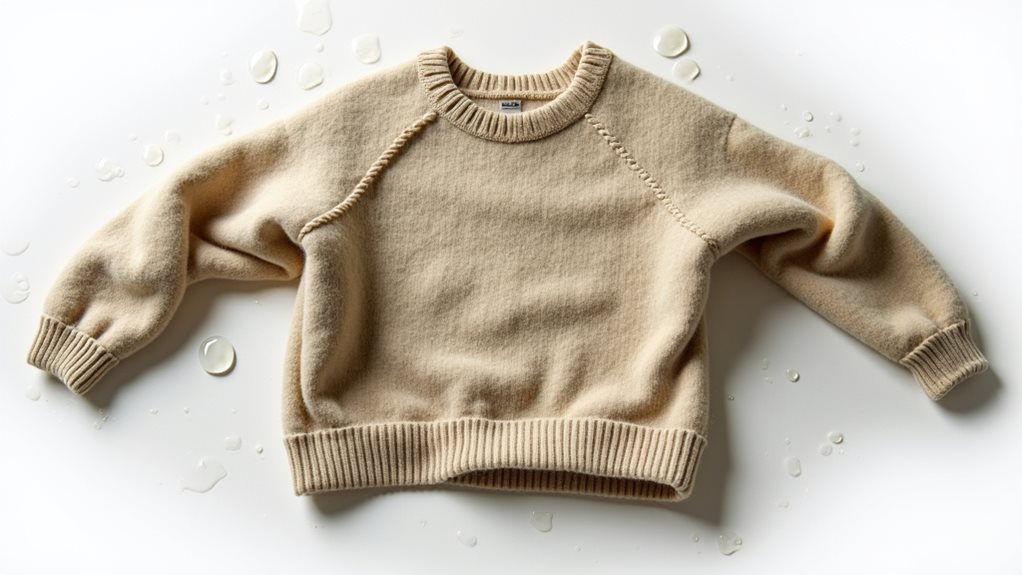
When you expose dry-clean-only fabrics to water, you’re fundamentally attacking their molecular structure at the fiber level, causing proteins in wool to contract and silk’s delicate weave to lose its integrity permanently.
The washing machine’s agitation then becomes the final blow, stretching and twisting these already compromised fibers until they can’t return to their original shape—think of it like trying to unscramble an egg after it’s been cooked.
I learned this the hard way when I threw my favorite cashmere sweater into the wash “just this once,” and watched it emerge looking like it belonged on a toddler instead of me 😅.
This damage occurs because home washing cannot replicate the specialized solvents used in professional dry cleaning, which are specifically designed to clean delicate fabrics without the destructive effects of water.
Water Damages Fabric Structure
Three things happen the moment water touches that “dry clean only” label hiding in your favorite silk blouse, and trust me, I learned this the hard way after ruining a gorgeous vintage dress I’d splurged on during a weekend trip to San Francisco 😅.
Water damage to fabric structure occurs instantly, and here’s what you’ll witness:
- Fiber swelling – Your delicate silk or wool fibers absorb water like tiny sponges, expanding beyond their natural capacity and permanently stretching the fabric’s molecular structure.
- Shape distortion – The garment’s carefully constructed silhouette warps as water disrupts the fabric’s tension, causing that perfect fit to become baggy and misshapen.
- Structural breakdown – Linings separate from outer layers, creating puckering and misalignment that makes your once-pristine garment look homemade.
These garments require chemical solvents for proper cleaning because their materials and construction methods cannot withstand the water immersion and agitation of traditional washing machines.
Agitation Causes Permanent Distortion
Although water alone wreaks havoc on delicate fabrics, the real nightmare begins when your washing machine’s agitation cycle kicks in, transforming what might’ve been a minor mishap into a complete textile catastrophe.
Picture your beautiful silk blouse getting tossed around like a rag doll—that’s exactly what’s happening to those precious fibers. The relentless spinning and churning creates permanent distortion that’ll make you want to cry 😢 when you pull out your now-misshapen garment.
I’ve witnessed wool sweaters emerge looking like they’d been through a blender, with fibers weakened beyond repair and pilling scattered across surfaces like textile dandruff.
Your delicate fabrics simply can’t handle this mechanical assault, resulting in fraying edges and structural damage that no amount of wishful thinking can reverse.
This is why professional dry cleaning uses chemical solvents instead of water-based washing to safely clean these vulnerable materials without causing the devastating agitation damage that home machines inevitably create.
Color and Texture Alterations That Occur

Since I learned this lesson the hard way with my favorite silk blouse, I can tell you that washing dry clean only garments creates a cascade of color and texture alterations that’ll make you want to cry into your laundry basket.
That gorgeous emerald dress you splurged on? Water will cause devastating color bleeding, turning your investment into a faded shadow of its former glory.
Water transforms your precious emerald investment into a heartbreaking, faded reminder of an expensive laundry disaster you’ll never forget.
Here’s what you’ll witness during this tragic transformation:
- Your silk’s lustrous shine vanishes, leaving behind a dull, lifeless fabric that screams “mistake”
- Wool sweaters shrink mercilessly, transforming from cozy comfort into miniature versions fit for dolls
- Velvet surfaces flatten completely, destroying that luxurious texture you originally fell in love with
Trust me, these texture alterations aren’t reversible – I’ve tried everything! 😭
While these physical damages are immediately visible, it’s worth noting that professional dry cleaning uses chemical solvents that can be safely removed through proper ventilation, unlike the permanent water damage from home washing.
When Your Clothes Become Completely Unwearable
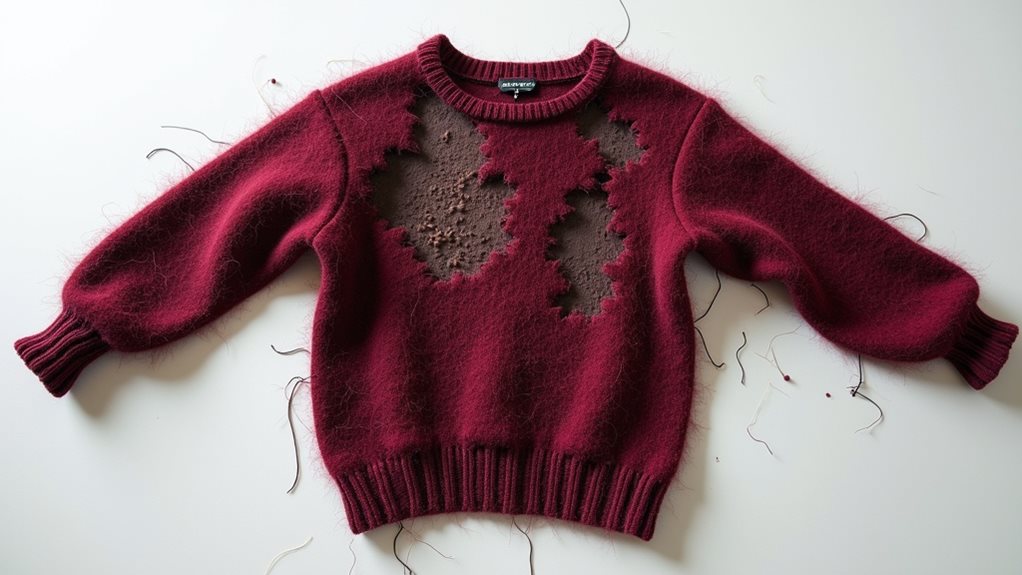
When the damage reaches its peak, you’ll face the heartbreaking moment where your once-beloved garment transforms into something so distorted that it’s literally impossible to wear.
I’ve watched friends hold up shrunken blazers that could barely fit a toddler, their faces reflecting pure devastation 😢.
Dry clean only fabrics become casualties of war when they meet your washing machine, with delicate items suffering the most catastrophic transformations.
That elegant silk blouse you adored? It’s now a twisted, misshapen mess with sleeves that resemble crumpled tissue paper.
Color bleeding creates abstract art you never wanted, turning your pristine white dress into a tie-dye nightmare.
These aren’t minor alterations you can overlook—they’re complete metamorphoses that render your garments absolutely unwearable.
Beaded or sequined garments face particularly brutal fates, as washing machines can tear off embellishments and destroy the delicate attachment threads that hold decorative elements in place.



